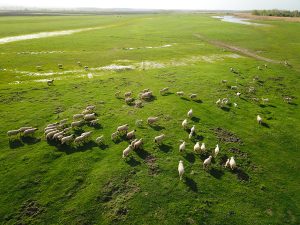Getting a read on premiums for Responsible Wool Standard (RWS) accredited wool is tricky, especially from an individual sale lot perspective. Wool growers understandably want to know the returns (premiums) for accessing accreditation to schemes such as RWS, so in this article, we look at RWS premiums for the calendar year to date (since the Christmas recess).
A quick background on how the range and median RWS premiums were calculated for this article. Relatively narrow sections of the Eastern Merino fleece auction market were used, to limit the effect of different wool characteristics on price. For each half micron, prices for RWS accredited and non-RWS were then calculated by sale week. For 19.0 micron and finer categories, the non-RWS price across the half-micron ranges varied by 8%. On the broader side, the variation in price across half-micron categories falls, with 21.8 to 21.2 (21 microns) having a range of around 2%. This shows there is an in-built variation in the premiums being calculated. Percentile levels from the weekly premiums were calculated to arrive at the median, low (10th percentile), and high (90th percentile).
For want of a suitable term, Figure 1 shows RWS premiums (median and range) for the best topmaker merino fleece (Eastern Australia, 70-95 mm staple length, 38 plus N/ktx staple strength, good yield, no subjective faults, 0-1% vegetable matter) from 15.5 to 21.5 micron. The median premium is shown in Australian cents per kg, starting at around 60 cents for 21 micron, rising to 115 for 18.5 micron, and then rising to 180-260 cents for sub-18.5 micron. In percentage terms, the premium is around 3-5% across the different micron categories.
The median shows what the supply chain is paying as a rule. The ranges for each micron show that individual lots can receive a premium well above or well below the median, hence the trouble trying to value this wool for sale. The in-built price variation above could account for 60-70% of the range, meaning simple differences in the fibre diameter of lots compared within half-micron ranges could explain a little over half of the range. Maybe.
Figure 2 repeats Figure 1 but compares the RWS accredited lots to comparable non-mulesed lots only, which becomes a problem for volume for average and broader merino wool. The picture shown in Figure 2 is more varied but follows a similar pattern to Figure 1 for the variation in premiums and the median levels. A comparison of non-mulesed (& non-RWS) best top maker prices to comparable mulesed/non-declared prices shows median prices starting around 50 clean for 16.5 micron and finer, 20 cents for 17 through 18.5 micron and then falling to around 5 cents.
Finally, in Figure 3, the process is repeated for eastern Australian full-length merino fleece with a staple strength around 30 N/ktx, VM level of 0-1%, and no subjective faults. The premium story is noticeably different, with the median level mainly in the 50-60 cents range across the micron categories, still with plenty of variation. In percentage terms, the premiums are around 1.5-2%.
What does it mean?
As a rule of thumb, it appears good quality Merino fleece which is RWS accredited is picking up a premium of 3-5%, with lesser quality fleece picking up smaller premiums. The variation in premiums paid between lots remains an issue as it is quite wide, with relatively weak overall demand in the market not helping at present.
It seems likely Australia will follow the lead of South Africa and start to monitor quality scheme premiums as a block (RWS, SustainaWOOL, and Authentico) as the other schemes do seem to be performing well.
Have any questions or comments?
Key Points
- In average or median terms premiums are being paid for RWS-accredited Merino fleece wool, which is of reasonable quality.
- Around the median premium, there are significant ranges in the premiums being paid which is a significant issue for the sale performance of individual sale lots.
- Premiums look to be graded according to the quality of the fleece being sold.
Click on figure to expand
Click on figure to expand
Click on figure to expand
Data sources: AWEX, ICS, Mecardo















